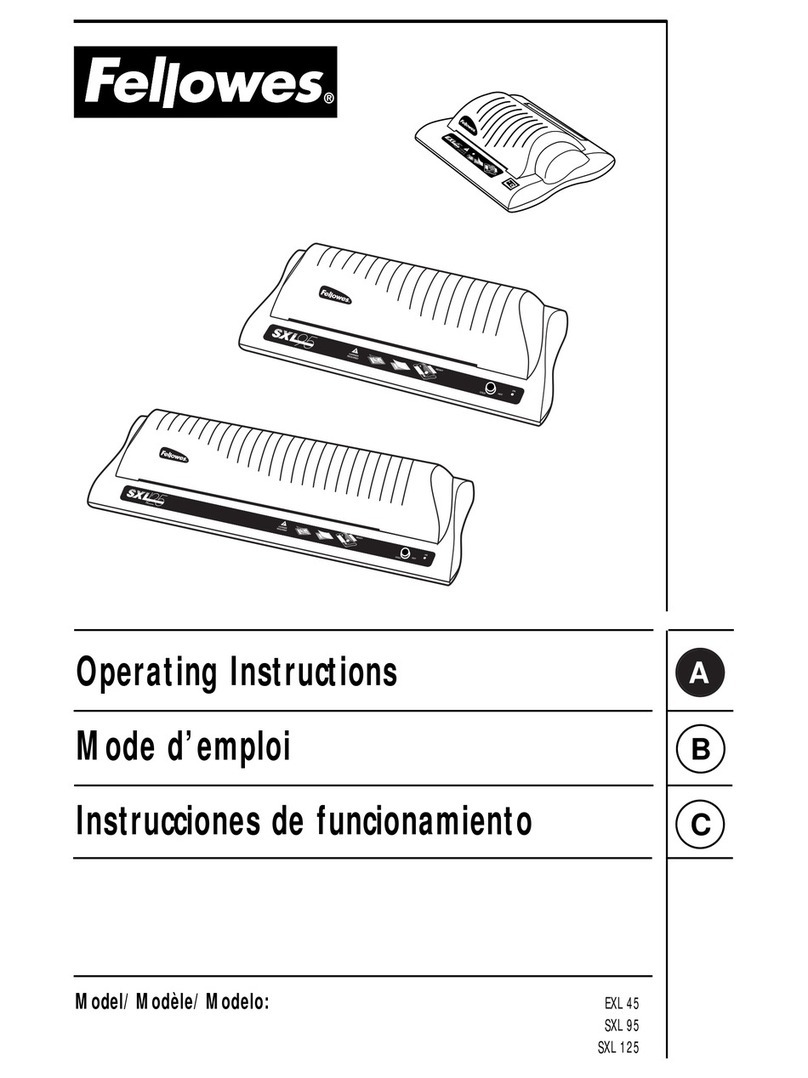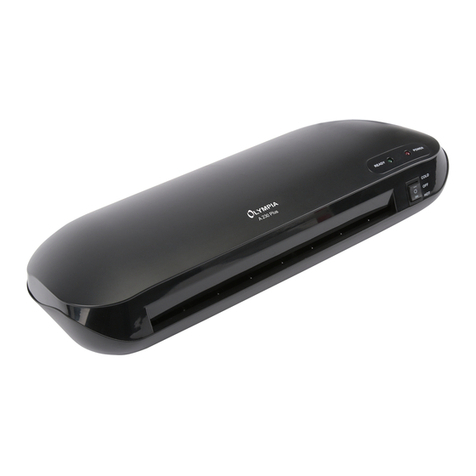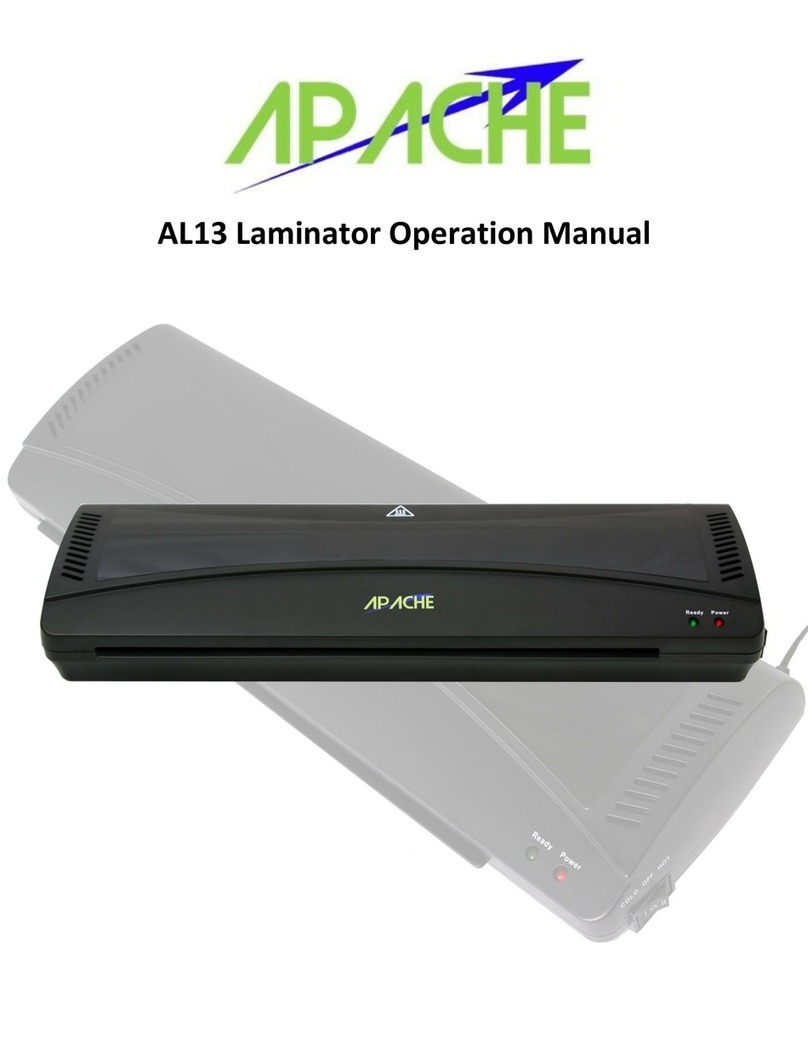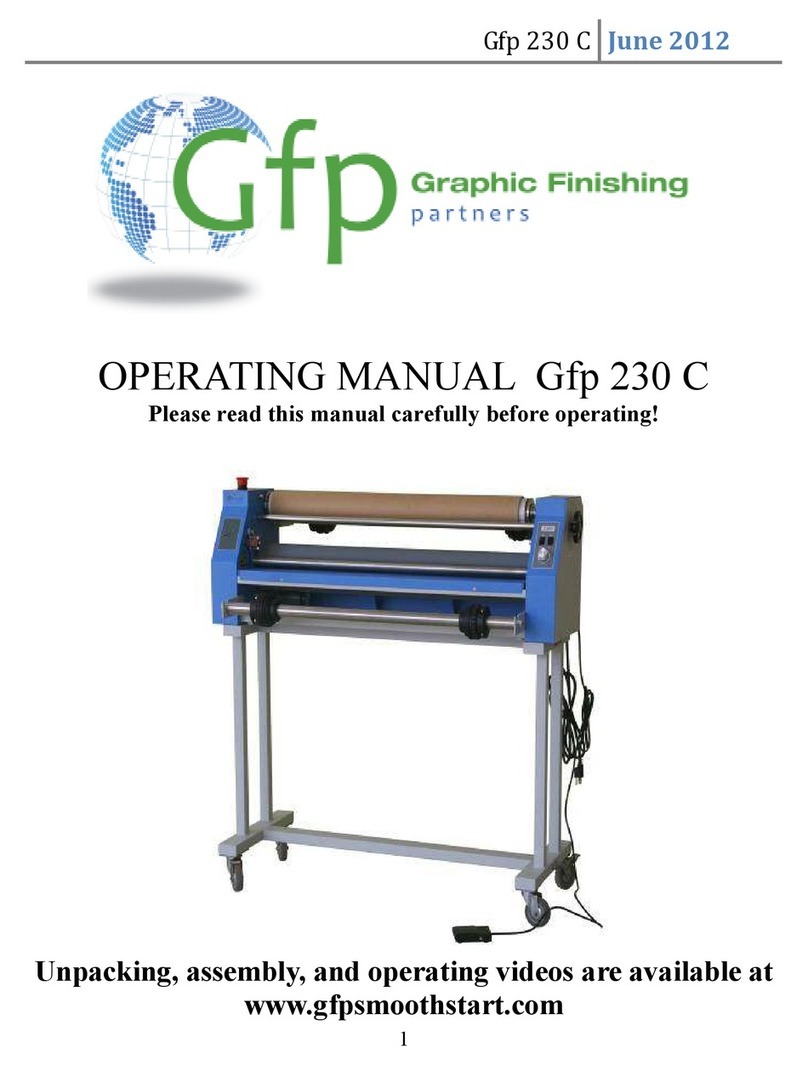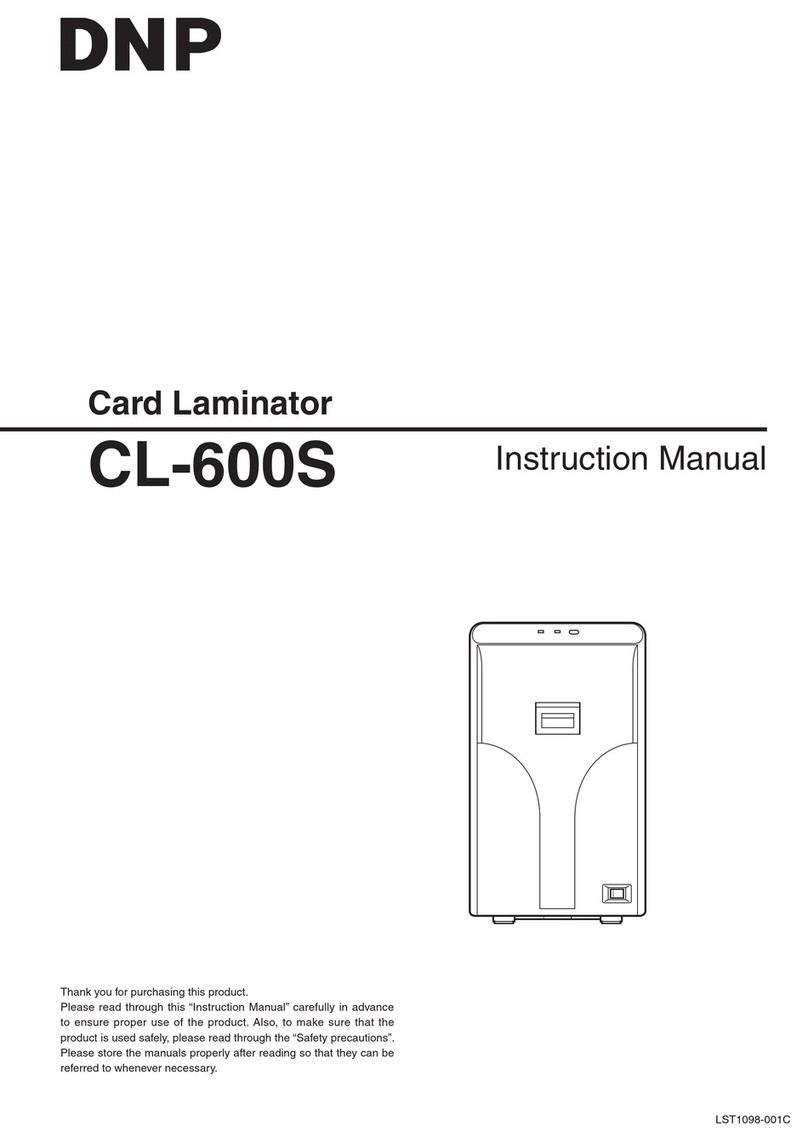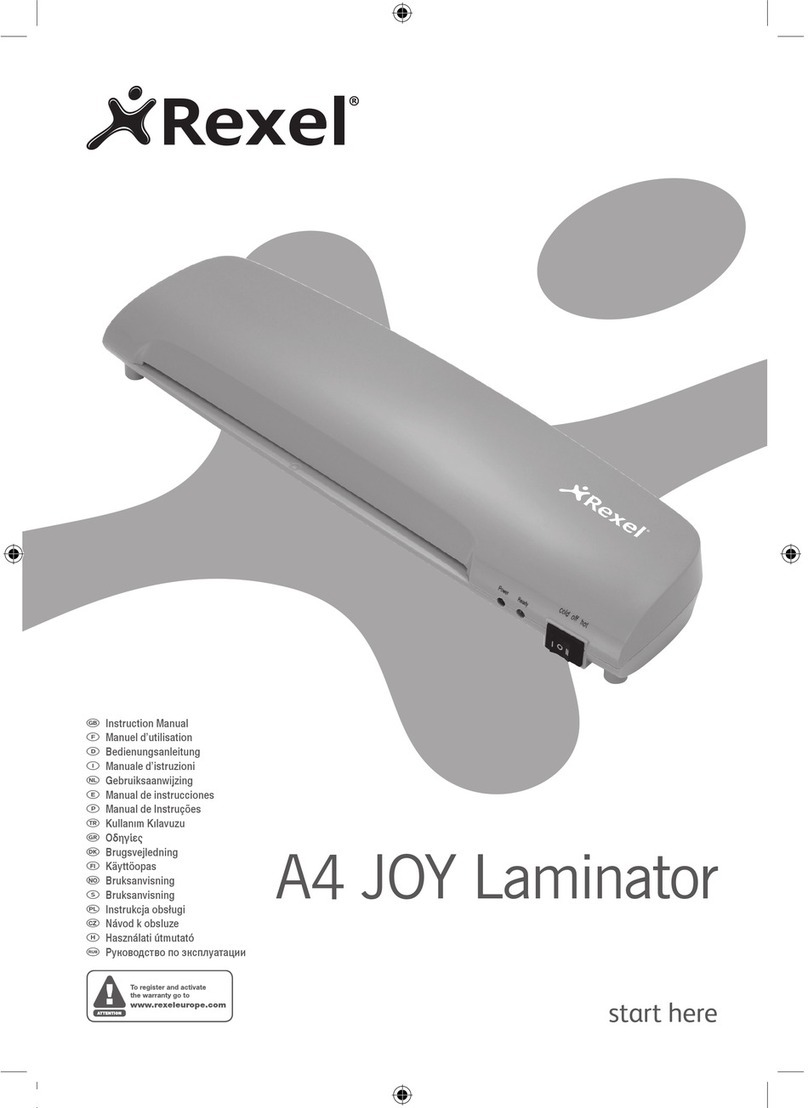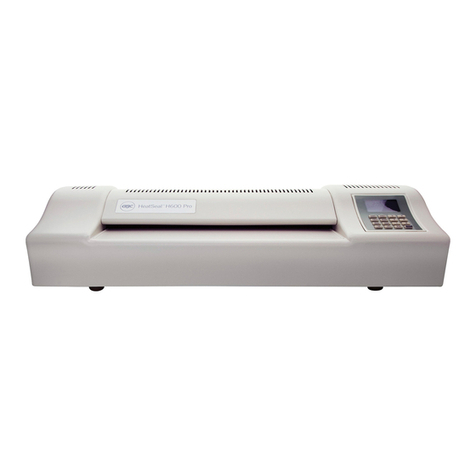Biedermann GmbH RollLam 120W User manual

OPERATION MANUAL
Laminators
RollLam 120W; RollLam 140W; RollLam 160W
Biedermann GmbH
Solutions for mounting and laminating
DE-70806 Kornwestheim, Heubergstraße 19
Phone:+49(0)7154-83990; Fax:+49( 0)7154-839983
www.biedermanngmbh.com

OPERATION MANUAL
Copyright
Biedermann GmbH, Kornwestheim
Translation, passing on to third parties as well as any kind of
duplication and publication are prohibited without prior written
permission and will result in legal action in accordance with the
applicable laws.
© November 2009
Manual RollLam 120W; RollLam 140W; RollLam 160W 2

OPERATION MANUAL
Introduction
This manual contains all information needed for the successful opera-
tion of your laminator.
Familiarize yourself with all details of your laminator prior to use.
Non-compliance with this operator's manual may cause a warranty
claim to become void, in case of damage.
The laminators are precision machines that are manufactured by using
high quality components. When designing these machines, functiona-
lity and operating comfort were of great importance. You will be satis-
fied with your machine for many years if you operate and maintain it
properly. Please become familiar with the most important elements of
your laminator according to the following manual, in order to be able to
always mount and laminate your pictures precisely, quickly and safely.
If you still have questions concerning your laminator, please do not
hesitate to contact us.
Biedermann GmbH
Heubergstraße 19
DE - 70806 Kornwestheim
Phone +49 (0) 71 54 / 83 99 - 0
Fax +49 (0) 71 54 / 83 99 - 83
www.biedermanngmbh.com
Manual RollLam 120W; RollLam 140W; RollLam 160W 3

OPERATION MANUAL
1
2
3
4
4.1
4.2
4.3
5
5.1
5.2
5.3
6
6.1
6.2
6.2.1
6.2.2
6.3
6.3.1
6.3.1.1
6.3.1.2
6.3.2
6.3.3
6.4
6.5
6.5.1
6.5.2
6.5.3
6.5.4
7
8
Contents
Safety instructions
Assembly and installation of the laminator
Technical specifications
Basic elements of the laminator
Front view
Rear view
Control panel
Adjustment of the laminator
Adjustment of the pressure
Adjustment of the brakes
Quick gripping cones
Applications
Coating of substrates
Mounting
Mounting on pre-coated substrates
Mounting large pictures on pre-coated substrates
Laminating
Laminating with the aid of working boards
Working with pre-cut laminates
Working from the roll
Laminating with the aid of silicone release paper
Laminating without working boards or silicone release paper
Laminating and coating with double sided adhesive
Working with accessories
Laminating on both sides
Working “from roll to roll“ / Working with self-adhesive vinyl films
Media holder
Additional supply shafts
How to clear minor faults by yourself
FAQ
5
6
7
8
8
9
10
12
12
12
13
14
14
15
15
16
18
18
18
19
21
23
25
27
27
29
29
30
31
33
Manual RollLam 120W; RollLam 140W; RollLam 160W 4

OPERATION MANUAL
1 Safety instructions
ATTENTION! To avoid contact with electricity, injuries and the
danger of fire, the following safety instructions must be followed
at all times. The instructions have to be read before using the
machine and have to be stored in a safe place.
1. SAFETY INSTALLATIONS: Check the efficiency of all safety
installations regularly. Do not change or remove the safety instal-
lations. Defective safety installations or damaged parts have to
be replaced by trained personnel.
2. WORK CLOTHES: Wear suitable work clothes: no loose gar-
ments or clothes with long sleeves, ties etc.
3. AVOID UNSECURE POSITIONS: Take up a secure position,
in which you can be balanced at all times.
4. NEAT WORKPLACE: Untidiness in the workplace increases
the risk of accident.
5. CARRY OUT YOUR WORK ATTENTIVELY: Do not let your-
self be distracted from work. A distraction can cause accidents.
6. ROOM CONDITIONS: Do not expose the machine to rain. Do
not use the machine in damp or wet rooms. Ensure lighting is
good. Do not use the machine close to flammable liquids or gas.
7. HAVE THE MACHINE REPAIRED BY PROFESSIONEL
PERSONNEL ONLY: When buying machines comply with the
effective saftey regulations. Repairs may only be carried out by
professionel personnel.
8. KEEP CHILDREN OUT OF REACH OF THE MACHINE: The
machine or the cables should not be touched by third parties,
especially children.
9. TAKE CARE OF THE POWER CABLE: Do not pull the power
cable to remove the plug from the socket. Protect the cables from
high temperatures, oil and sharp edges. Check all cables and
plugs regularly. In case of damage have them replaced by quali-
fied personnel. Check extensions regularly and replace them if
damaged.
10. ELECTRIC SUPPLY CABLES: Take care that the electric
supply cables are not damaged by the laminator wheels running
over them, or catching them. Make sure that they are not a trip-
ping hazard.
Manual RollLam 120W; RollLam 140W; RollLam 160W 5

OPERATION MANUAL
Manual RollLam 120W; RollLam 140W; RollLam 160W 6
2 Assembly and installation of
the laminator
Assembly
of the stand
The stand consists of several parts which have to be assembled
after receiving the machine. To guarantee sufficient stability of
the stand securely tighten the connecting screws.
ATTENTION: Pay attention to the front and rear side of the
stand (see manual for the assembly of the stand)!
Unpacking of the
laminator
Remove the screws from the places marked with an arrow. Re-
move the lid of the box and lift the machine onto the stand.
ATTENTION: Make sure the stand is the correct way round
(front of machine on front of stand & rear of machine on rear
of stand)!
Installation of the
supply shaft holders
The holders for the top supply shaft (1) as well as the bottom
supply shaft (13) have to be installed after the installation of the
machine. Mount the holders according to the marking with the
letters „a“, „b“, „c“ and „d on the appropriate device on the ma-
chine.
ATTENTION: The holders have to be installed at the same
height to avoid the occurence of wrinkles during the working
process. For this purpose press down the holders with a
little pressure before screwing them tight!
Picture 1
Holders for the supply shafts
Connection to the electricity
network
Connect the machine to the electricity network by means of the
power plug.
ATTENTION: Be aware of the safety instructions!

OPERATION MANUAL
Model RollLam 120W RollLam 140W RollLam 160W
Thermoelement 30°C-60°C 30°C-60°C 30°C-60°C
Working width / Roller width 120 cm / 130 cm 140 cm / 150 cm 160 cm / 170 cm
Width / depth / height 170 / 68 / 121 cm 190 / 68 / 121 cm 210 / 68 / 121 cm
Height of front worktable 87,5 cm 87,5 cm 87,5 cm
Weight 168 kg 188 kg 218 kg
Max. board thickness 25 mm 25 mm 25 mm
Diameter of rollers 112 mm 112 mm 130 mm
Max. speed 3,5 m/min 3,5 m/min 4 m/min
Voltage 230V / 0,9 KW 230V / 1,0 KW 230V / 1,3 KW
Adjustment of height central central central
Finger protection yes yes yes
Silicone rollers yes yes yes
Foot switch yes yes yes
Supply shaft and take-up unit
(at the top) yes yes yes
Supply shaft (at the bottom) yes yes yes
Quick gripping cones yes yes yes
Forward and reverse action yes yes yes
Speed adjustable yes yes yes
CE-certificate yes yes yes
Manual RollLam 120W; RollLam 140W; RollLam 160W 7
3 Technical specifications

OPERATION MANUAL
Picture 2
Front view laminator
Manual RollLam 120W; RollLam 140W; RollLam 160W 8
4 Basic elements of the
laminator
4.1 Front view
1 Top supply shaft with brakes and quick gripping cones
2 Take-up unit
3 Hand wheel for pressure adjustment
4 Pressure transmission shaft
5 Emergency stop switch
6 Top roller
7 Finger protection with integrated feed-in roller
8 Front working table with swing-out option and scale
9 Switching axis
10 Stand on wheels
11 Connection for the foot switch
12 Control panel
13 Bottom supply shaft with brakes and quick gripping cones
14 Jig for additional supply shafts
15 Connector for the take-up unit at the front side

OPERATION MANUAL
Picture 3
Rear view laminator
Manual RollLam 120W; RollLam 140W; RollLam 160W 9
4.2 Rear view
16 Connecting cable
17 Main switch
18 Fuse for the heating element
19 Fuse for the controller
20 Connector for the take-up unit at the backside
21 Rail with temperature sensor
22 Jig for additional supply shafts

OPERATION MANUAL
Manual RollLam 120W; RollLam 140W; RollLam 160W 10
Picture 4
Control panel
4.3 Control panel
1 Control lamp for cold operation
2 Control lamp for warm operation
3 Temperature control lamp
4 Temperature display
5 Temperature regulator
6 Speed regulator
7 Continuous operation/Foot operation switch
8 Forward/Reverse operation switch
9 Cold/Warm operation switch
Preparations
1. Make sure that the emergency stop switches are switched off.
2. Switch off the speed regulator (6).
3. Switch on the main switch (17).
4. Adjust the requested temperature and wait until the control
lamp (3) starts to light.
5. Operation with the foot switch: When selecting switch (7) to
“Step“ the roller is driven by foot switch. By activating the foot
switch the drive roller starts to move. When taking the foot off
the foot switch the drive roller stops. The speed can be adjust-
ed with the speed regulator (6).
ATTENTION: When working with the foot switch the safety
light barrier which is integrated in the machine becomes
non-operational!

OPERATION MANUAL
Manual RollLam 120W; RollLam 140W; RollLam 160W 11
6. Continuous operation: When selecting switch (7) to
“Continue“ the roller is driven continuously. The speed can be
adjusted with the speed regulator (6).
For safety reasons continuous working is only possible in the
forward mode and up to a max. board thickness of 12 mm.
This is secured by the safety light barrier. If the safety light bar-
rier stops the rollers it is necessary to switch over to “Step“ be-
fore continuous working is possible again.
7. Backward operation:When selecting switch (8) to “Reversal“
the backwards mode is activated. By pressing the foot switch
the drive roller starts to move backwards.
ATTENTION: For safety reasons a continuous operation
in the backwards mode is not possible!
Warming-up of the top roller
Adjust the requested temperature with the temperature regulator
(5). The recommended temperature is 30-40°C. Switch over
switch (9) to “Hot” and wait until the control lamp (3) starts to
light.
ATTENTION: For an even warming-up the rollers should not
touch each other during the warm-up phase!

OPERATION MANUAL
Manual RollLam 120W; RollLam 140W; RollLam 160W 12
5 Adjustment of the
laminator
5.1 Adjustment of the pressure
Generally the pressure is adjusted by lifting and lowering the top
roller. In order to make the right adjustment use a piece of a ma-
terial in the same thickness as the substrate or the picture which
has to be laminated. Lay the substrate/picture in-between the
rollers and lower the top roller with the hand wheel. The hand
wheel has to be turned until the top roller lies on and grips the
material (“contact zone”). From this point turn the hand wheel
clockwise approx. 30, maximal 40 degrees more.
ATTENTION: Too much pressure can cause the occurrence
of waves!
Picture 5
Hand wheel
5.2 Adjustment of the brakes
The supply shafts are equipped with an integrated brake mecha-
nism in the quick gripping cones (A). This allows the film to be as
tight as required. There is no parameter that determines the exact
tension – this depends on numerous factors. Every material has
its own specific properties which can change in subject to tem-
perature, humidity, adhesive type, consistence of the film etc.
You can say that you have ideal conditions if the film spreads
over the top roller and goes into the rollers without wrinkles with
minimum braking effect. The search for this balance starts from
the point where the brakes have a small effect and must be in-
creased little by little.

OPERATION MANUAL
Manual RollLam 120W; RollLam 140W; RollLam 160W 13
Generally less tension is better to avoid the laminated picture
bending. Furthermore the regulation of the braking effect has to
be done from both sides equally. In the case of a one sided o-
peration of the brakes, the film can switch on the supply shaft
what can lead to wrinkles.
ADVICE: When loading the film tighten the brakes a little bit
stronger. As soon as the film is optimally adjusted loosen
the brakes!
Picture 6
Quick gripping cones with inte-
grated brake mechanism
5.3 Quick gripping cones
Besides the regulation of the tension of the film the quick gripping
cones allow the positioning (right and left shift) of the film. When
loading the film onto the supply shaft leave a gap of 5 mm be-
tween the clamp and the braking wheel (B) to ensure the possibil-
ity of the repositioning of the film. Thus if required the film can be
shifted to the right or to the left to correct a potential warp which
can occur during loading the film onto the supply shaft.
Picture 7
Positioning of the film
A
B

OPERATION MANUAL
6 Applications
6.1 Coating of substrates
Required materials
■A double sided adhesive film (e.g. ArtMount S or AdMount)
■A “ threading board” (a strip of Forex, PVC or a similar mate-
rial (approx. 25 cm x width of the film, in the same thickness as
the substrate)
Sequence
1. Adjust the pressure according to the thickness of the substrate
(see p.12).
2. Load the double sided adhesive film onto the top supply shaft
(1) so that the film can be pulled toward the user from the
underside of the roll with the silicone release paper side facing
to the bottom.
3. Pull the double sided adhesive film to the front underneath the
pressure transmission shaft (4) and lay it loosely over the top
roller (6).
4. Push the film evenly in-between the rollers by using the
threading board so that the film is tight & wrinkle-free. Finally
feed-in the substrate. Due to economic reasons it is recom-
mended to coat several boards in succession.
ATTENTION: To avoid the adhesive film sticking to the
bottom roller, feed-in the boards without interspace!
Working boards
A working board is a board made of Forex, PVC, aluminium or a
similar material (no sharp edges) coated with a double sided ad-
hesive film.
ATTENTION: Do not remove the silicone paper!
The following explanations will show that working boards are
used in various applications. Therefore it is recommended to
have several working boards as basic equipment.
To make a working board please follow the explanations above.
Manual RollLam 120W; RollLam 140W; RollLam 160W 14

OPERATION MANUAL
6.2 Mounting
6.2.1 Mounting on pre-coated
substrates
Required materials
■A mounting board (a substrate coated with double sided adhe-
sive film)
Sequence
1. Adjust the pressure according to the thickness of the substrate
(see p.12).
2. Peel off approx. 2 - 3 cm of the cover paper (silicone
release paper) of the mounting board and fold it back to
expose a strip of adhesive.
3. Lay the picture on the substrate, position it over the folding
edge and align it with the top edge of the substrate.
4. Stick the leading edge of the print onto the exposed adhesive
strip.
ATTENTION: Do not apply too much pressure to stick the
picture onto the exposed adhesive. Too much and
irregular pressure can lead to wrinkling!
5. Push the mounting board with the tacked picture manually
between the rollers. To guarantee a proper fixation continue to
insert the picture and the board approx. 1 cm between the roll-
ers by using the foot switch (take care that the release liner is
not caught between the rollers).
6. Drape the picture over the top roller (6).
7. Peel back the cover paper for further 30 cm.
8. Feed in the substrate slowly and start with the mounting
process. At the same time adjust the picture on the roller and
pull off the cover paper as evenly as possible.
ATTENTION: Take care that no dirt, for example dust,
comes in-between the picture and the mounting board!
Manual RollLam 120W; RollLam 140W; RollLam 160W 15

OPERATION MANUAL
6.2.2 Mounting large pictures on pre-coated
substrates
Required materials
■A mounting board (a substrate coated with double sided adhe-
sive film)
Advice
Especially when mounting large pictures (starting from 1,50 x
3,00 m) it is difficult to mount the picture precisely onto the sub-
strate. The process explained below simplifies the handling of
large pictures and shows how to achieve optimal results even
with large pictures.
Sequence
1. Adjust the rollers approx. 5 mm bigger than the thickness of
the substrate.
2. Cut the picture according to the size of the substrate.
3. Lay the picture on the substrate and position it so that the
rollers are in the middle of the picture.
4. Align the picture with the substrate. Lower the top roller
with the hand wheel (3) so that the picture and the substrate
are fixed between the rollers. This will avoid the picture shift-
ing.
5. Drape the front part of the picture over the top roller (6).
ADVICE: If you work alone, weight the draped part of the
picture to prevent it turning back!
6. Peel off the cover paper from the mounting board and cut it
carefully on the level of the roller. Take care in keeping the cut
edge clean.
ATTENTION: Do not score or cut into the roller!
7. Take the weight off the picture, however continue to hold
back the picture with your hand.
8. Run the mounting board through the rollers and start with the
mounting process. At the same time release the picture
evenly and smooth out the picture from time to time along the
top roller (6).
9. Take out the half-mounted picture, turn it and run it
through the rollers up to the part that is already mounted.
10. Fix the mounting board and drape the front part of the picture
over the roller (6).
11. Peel off the cover paper from the mounting board.
Manual RollLam 120W; RollLam 140W; RollLam 160W 16

OPERATION MANUAL
12. Run the mounting board through the rollers and start with the
mounting process. At the same time release the picture
evenly and smooth out the picture from time to time along the
top roller (6).
Self-adhesive vinyl films
The sequence explained above is similar when mounting pictures
already coated with adhesive (for example self-adhesive vinyl
films). However the cover paper is removed from the coated pic-
ture instead of from the substrate.
Manual RollLam 120W; RollLam 140W; RollLam 160W 17

OPERATION MANUAL
6.3 Laminating
6.3.1 Laminating with the aid of working boards
6.3.1.1 Working with pre-cut laminates
Required materials
■A laminating film (e.g. ProLam or AdLam)
■A working board (see p.14)
Sequence
1. Adjust the pressure according to the thickness of the working
board (see p.12).
2. Cut the laminating film to the required size.
The film should be larger than the picture: approx. 3 cm at the
top and bottom and approx. 2 cm at each side.
3. Peel off approx. 2 - 3 cm of the cover paper (silicone re-
lease paper) of the laminate and fold it back to expose a
strip of adhesive.
4. Align the adhesive strip with the working board and fix it with a
little pressure.
5. Run the working board with the laminating film through the
rollers (by using the foot switch) so that approx. 1 cm of the
laminating film is fixed between the rollers.
6. Drape the laminating film over the top roller (6).
7. Continue to peel off the cover paper and fix it with a sticky tape
on the take-up unit (2) to assure an even removal of the
silicone paper.
8. Lay the picture on the working board, align it and start with
the lamination process.
ADVICE: When laminating small pictures the silicone re-
lease paper can also be peeled-off by hand. To adhere
the silicone paper on the take-up unit (step 7) is not ne-
cessary!
Manual RollLam 120W; RollLam 140W; RollLam 160W 18

OPERATION MANUAL
6.3.1.2 Working from the roll
Required materials
■A laminating film (e.g. ProLam or AdLam)
■A threading board (see p.14)
■A working board (see p.14)
ATTENTION: The threading and the working board should
have the same thickness!
Advice
If the laminating film is wider than the picture there is the risk that
the film will stick on the bottom roller during the lamination pro-
cess. To avoid this happening and to make the lamination pro-
cess as easy as possible there are two options: the use of sili-
cone release paper (see p. 21f.) or the use of working boards.
The second is explained below:
1. Adjust the rollers approx. 5 mm bigger than the thickness of
the threading/working board.
2. Equip the take-up unit (2) with a core. For this purpose push
the take-up unit towards the metal spring on the right side and
take it off to the top.
ATTENTION: If you look from the right side the barbed
hooks in the middle of the take-up unit must be adjusted
clockwise!
3. Load the laminating film onto the top supply shaft (1) so that
the film can be pulled toward the user from the underside of
the roll with the silicone release paper side facing to the bot-
tom.
4. Pull off the laminating film (incl. cover paper) from the sup-
ply shaft until it can be wrapped around the core from the bot-
tom. Fix the film (incl. cover paper) on the core with an ad-
hesive strip and wind up one rotation by hand. Adjust the
brakes on the cones so that the film can be unwound easily
but stays tight.
ATTENTION: Too much tension can lead to wrinkling!
5. Cut the laminating film widthwise.
ATTENTION: Just cut the film not the cover paper!
6. Peel off the separated laminating film carefully from the cover
paper and pull it to the front until it lies loosely over the top
roller (6) and approx. 10 cm over the working table.
Wind back the silicone release paper manually onto the take
up unit (2).
7. Push the film evenly between the rollers by using the threading
board so that the film is tight without wrinkles.
8. Lower the top roller (6) and adjust the pressure according to
the thickness of the threading/working board (see p. 12).
Manual RollLam 120W; RollLam 140W; RollLam 160W 19

OPERATION MANUAL
9. Feed-in the threading board (with the foot switch). If neces-
sary regulate the tension of the film with the aid of the brakes
on the cones.
10. Align the picture with the working board.
11. Feed-in the working board with the picture subsequent to the
threading board and start with the lamination process.
ATTENTION: Do not stop the machine during the lamina-
tion process to avoid marks on the picture!
Manual RollLam 120W; RollLam 140W; RollLam 160W 20
This manual suits for next models
5
Table of contents
